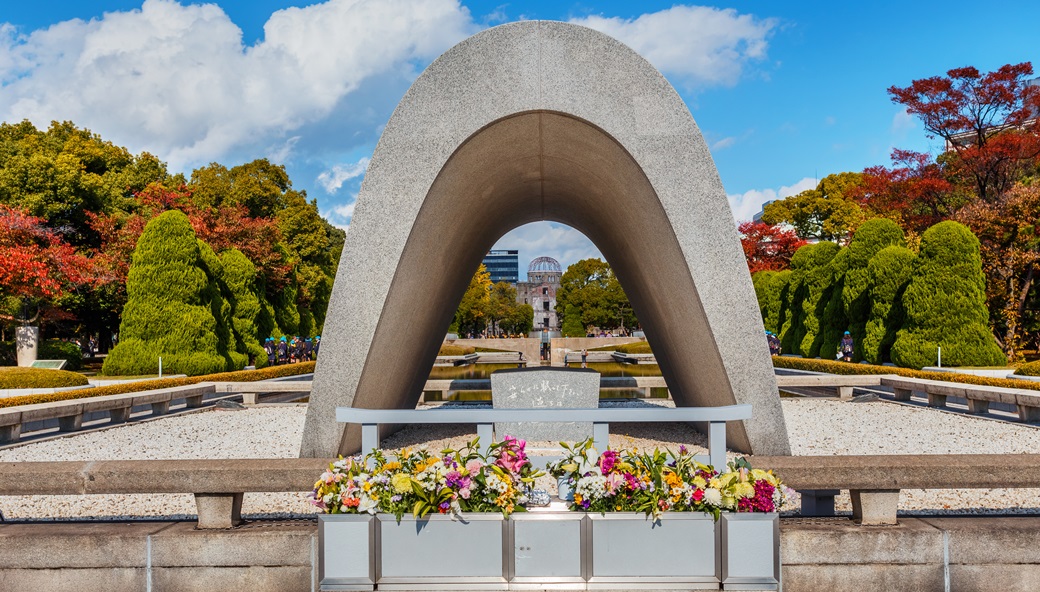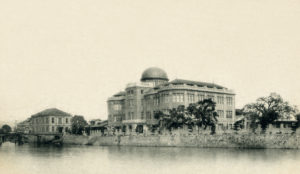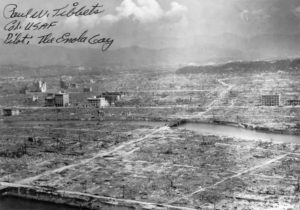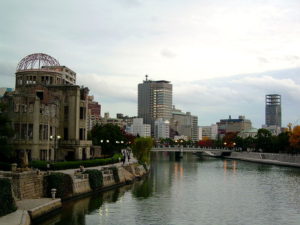Hiroshima is the capital of Hiroshima Prefecture and the largest city in the Chūgoku region of western Honshu, the largest island of Japan.
Hiroshima gained city status on April 1, 1889. As of August 2016, the city has an estimated population of 1,196,274. The gross domestic product (GDP) in Greater Hiroshima is $61.3 billion (US) as of 2010.
We mention these dry statistics by way of not launching directly into the only thing most people know about Hiroshima: that it was the first city in history to be targeted by a nuclear weapon.
The United States Army Air Forces (USAAF) dropped an atomic bomb on the city at 8:15 a.m. on August 6, 1945, near the end of World War II.
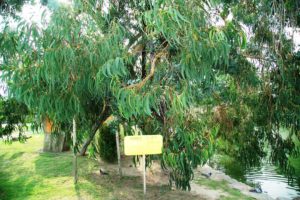
Eucalyptus tree at Hiroshima Castle. It’s just 740 meters from Ground Zero, but survived the bomb. Photo by Anonymous via Wikipedia.
But as early as autumn of 1945, weeds began to sprout from the scorched earth, confounding the expert’s predictions. The following summer, oleanders bloomed. Camphor trees (Eucalyptus) – many of them hundreds of years old – sprouted new branches.
Their recovery touched the hearts of local people. The oleander and the camphor were later proclaimed Hiroshima’s official flower and tree, cherished symbols of the city’s resilience.
Meanwhile, help poured in from all over Japan and abroad, from street cars to get the town up and running to trees to replace the vanished greenery.
But the key step in the city’s regeneration happened on August 6, 1949, with the enactment of the Hiroshima Peace Memorial City Construction Law.
That 1949 Construction Law didn’t envisage simply rebuilding the city. At the initiative of its mayor, Shinzo Hamai (1905–1968), it completely reimagined Hiroshima as a Peace Memorial City “to symbolize the … sincere pursuit of genuine and lasting peace”. For the first time in world history, an entire city underwent efforts to devote itself to the promotion of peace. It’s an ideal that Hiroshima’s residents still strive for.
As the world’s City of Peace, the city received more international attention as a desirable location for holding international conferences on peace, as well as on social issues.To further that momentum, the Hiroshima Interpreters’ and Guide’s Association (HIGA) was established in 1992 in order to facilitate interpretation for conferences, and the Hiroshima Peace Institute was established in 1998 within Hiroshima University.
The Nakajima area where Hiroshima Peace Memorial Park is located is the center of Hiroshima City, which began to flourish in the Edo period more than 400 years ago as the nexus of traffic linking Osaka, Kyushu and Shikoku. But it was instantly eradicated by the 1945 bomb.
A project to make the area into a peace memorial facility started in 1949 and has developed into the current Hiroshima Peace Memorial Park, which is as wide as some 122,100 square meters. More than 60 monuments and facilities, built in hopes of peace, are dotted in the park.
“Must-see” places in the park include the Hiroshima Peace Memorial Museum, which displays items to show conditions in the city at the time of atomic bombing, the Hiroshima Peace Memorial or Genbaku (A-Bomb) Dome designated as a World Cultural Heritage site to pass the horror and misery caused by the atomic bombing to future generations, and the Hiroshima National Peace Memorial Hall for the Atomic Bomb Victims to bring down experiences of the bombing while winning understanding from people in the world.
Recognition of atomic bombing through various historical facts should make visitors think that the horror and misery of the bombing must not be repeated. There also is the International Conference Center Hiroshima in the park.
The city government continues to advocate the abolition of all nuclear weapons and the mayor of Hiroshima is the president of Mayors for Peace, an international mayoral organization mobilizing cities and citizens worldwide to abolish and eliminate nuclear weapons by the year 2020.
On May 27, 2016, Barack Obama visited Hiroshima, being the first sitting president of the United States to visit since the dropping of the atomic bomb.
Today, visitors invariably leave the city with an overwhelming feeling of admiration and respect for the tremendous character of Hiroshima’s residents. They resolved to pick themselves up and start all over again, turning their tragic experience into a force for good in the world.
Many visitors also say they experience a notable spike in their levels of empathy, compassion and altruism. It’s what you might call “the Hiroshima Effect”.
Featured photo of Hiroshima Peace Memorial Park via Adobe Stock.

